I have to confess; I really enjoy taking photos of things with antlers. The annual cycle of growing, using, and losing antlers is a fascinating bit of natural history, plus their owners are magnificent animals that are just fascinating to watch. It gets me out of the house and my Covid pandemic prevention state as well and that makes deer photography as good as any pill for what ails me.
The white-tailed deer of Villa Park and surrounding areas have finished their annual breeding season, known as the rut. During that stressful season, the bucks have been intimidating foes and impressing potential mates with their antlers and bigger antlers are better. Large antlers, in the communications department of Deer, Inc., denote good genetics, abundant food, and good health--all desirable qualities in fending off rivals and attracting mates.
Antlers are different than horns. Horns are permanent growths that keep growing and wearing (or chipping off). Animals that have horns include sheep, cows, bison, and antelopes. Antlers, such as those that adorn the crowns of of the white-tailed deer, are grown and shed each year, usually about now, and they begin to regrow in spring. The largest antlered bucks are usually 5-7 years old and the shedding of the antlers allows them to increasingly grow larger antlers as they mature.
The process of growing antlers is driven by a cycle of hormones. The deer right now are shedding their antlers in Villa Park as testosterone levels drop to their lowest levels of the year. The pedicel, where the antler connects to the skull, weakens and at some point the antlers drop off leaving a raw area that scabs over. At this point some folks, like the two men I ran into a week ago in Villa, make it a hobby to search the woods to find these dropped "sheds." Since I don't see many bucks in Villa at this time of year--it is primarily a fall and early winter spot for bucks--this probably isn't the best place to hunt shed antlers as the deer are usually someplace else when the antlers drop.
Testosterone levels stay low until spring when they slowly begin to rise spurring antler growth. The new antlers are covered with a soft "velvet" skin rich in blood vessels that nourishes the rapidly-growing underlying tissues.
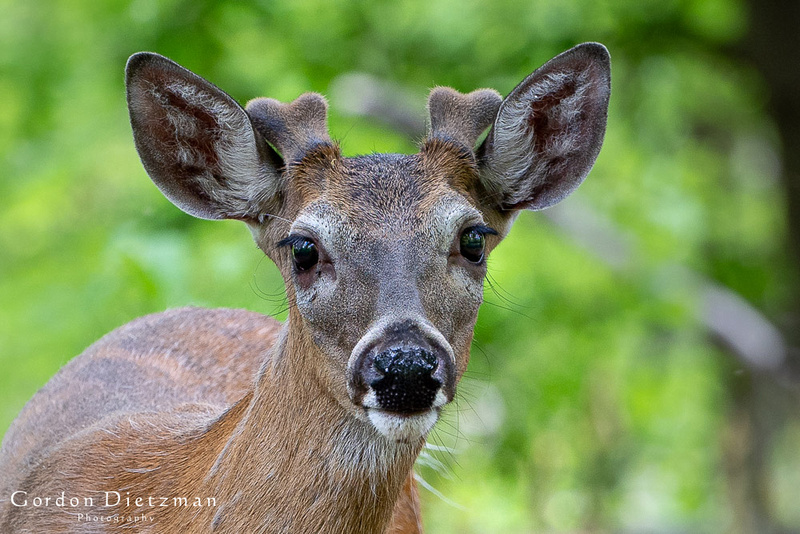 Velvet Stage of Antler GrowthThe velvet stage of antler growth is seen here on a buck that I photographed in my backyard, which backs up to Villa Park.
Velvet Stage of Antler GrowthThe velvet stage of antler growth is seen here on a buck that I photographed in my backyard, which backs up to Villa Park. 
I took the above photo in May while the photo below was taken a month later. These two bucks, I believe, are two different animals, although we rarely get bucks in our backyard in summer. Despite that you can get an idea of how fast antlers grow. It's also interesting that calcium is an important part of antler growth and so the bucks need a lot of calcium-rich foods for maximum antler growth, which is mediated, of course, by genetics and other factors. Does don't grow antlers but they need calcium for the bones of developing embryos and for milk once their fawns are born. Interestingly, bucks and does need about the same amount of calcium but just for different purposes.
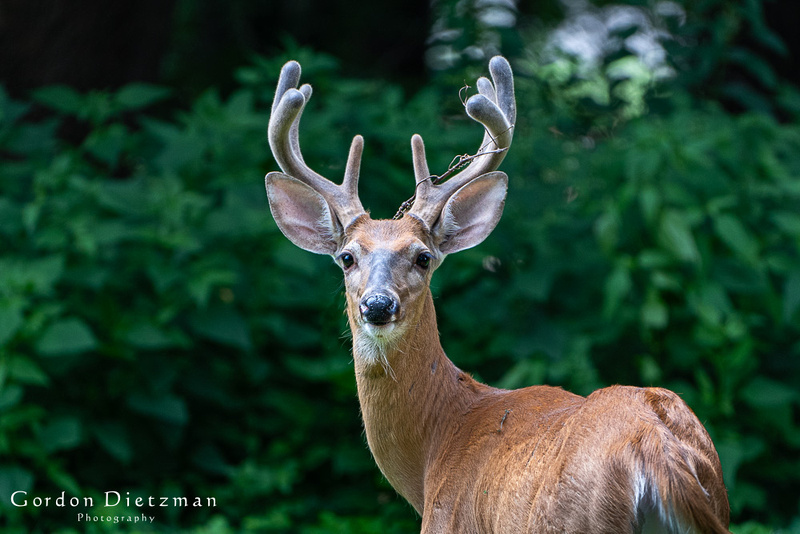 20200725-04698
20200725-04698 Later in August testosterone levels continue to peak and the relatively soft bone calcifies and harden as in the photo below. The bucks then thrash bushes stripping off the velvet. The blood along with sap from the bushes often stain the antlers a dark brown, although the tines may remain light-colored due to wear. By late October testosterone levels are at their highest and bucks that have been pals since the previous winter began to see those buddies as rivals and by November violent dominance fights may break out among those former friends.
Later in August testosterone levels continue to peak and the relatively soft bone calcifies and harden as in the photo below. The bucks then thrash bushes stripping off the velvet. The blood along with sap from the bushes often stain the antlers a dark brown, although the tines may remain light-colored due to wear. By late October testosterone levels are at their highest and bucks that have been pals since the previous winter began to see those buddies as rivals and by November violent dominance fights may break out among those former friends.
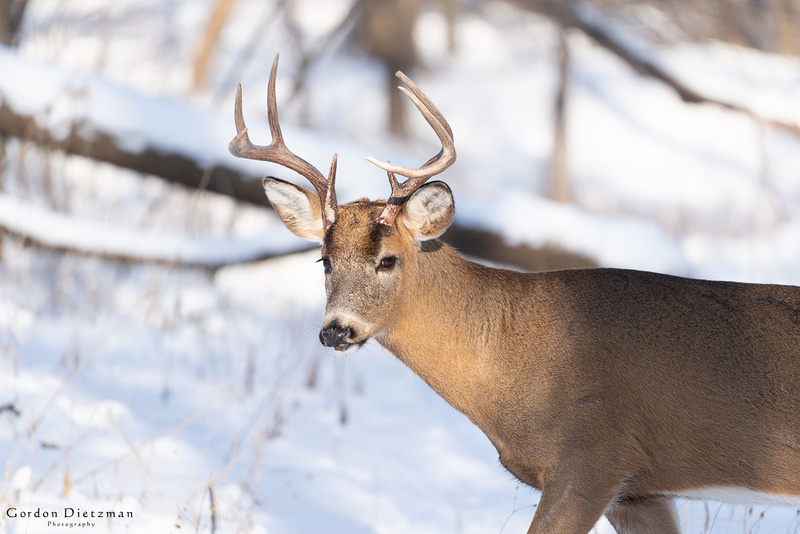 20210103-05100
20210103-05100
The photo above shows the fully-antlered buck with the velvet stripped off. I photographed this particular buck numerous times this fall and this photo and the next two are of the same animal. The above photograph was taken on January 3. The photograph below was taken a month later on February 4. He's lost one antler (both antlers rarely drop at the same time).
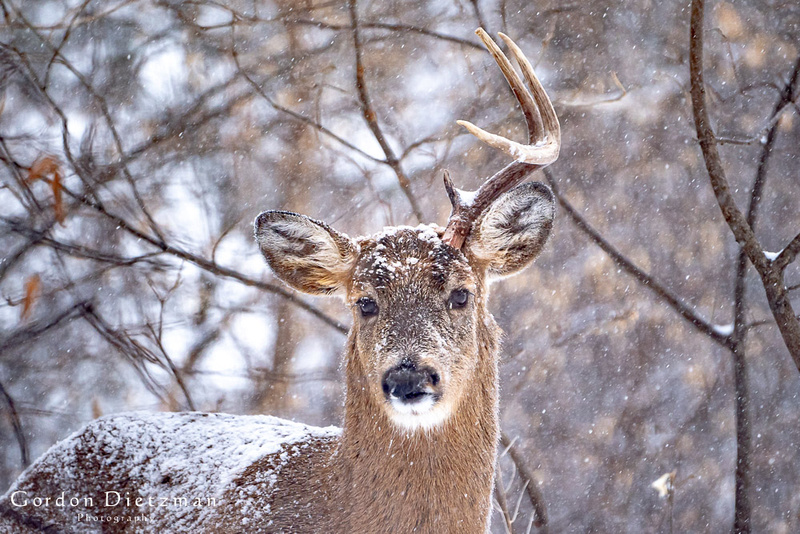 20210204-09330
20210204-09330
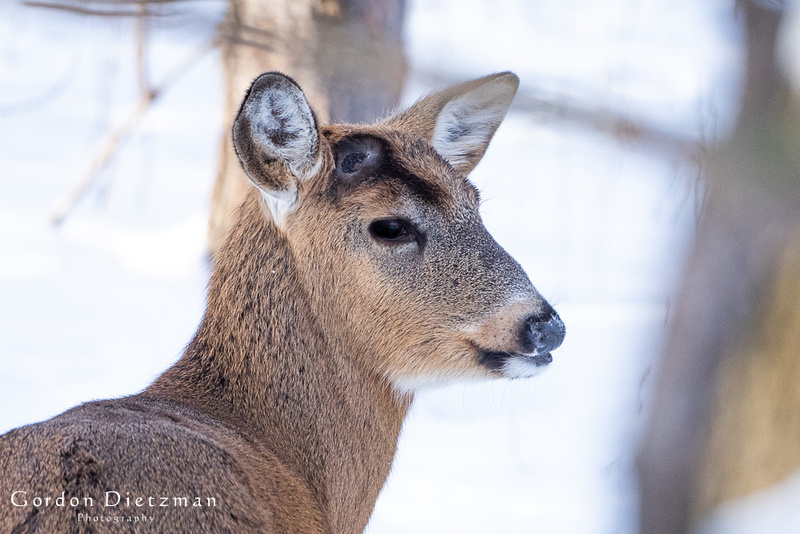 DSC09634
DSC09634 In the photograph above, taken on February 6, the buck has now lost both antlers and the pedicel on this side is scabbing over.
In the photograph above, taken on February 6, the buck has now lost both antlers and the pedicel on this side is scabbing over.
There are, however, some conditions that may interfere with the cycle. Injuries and stress may cause the bucks to drop their antlers early. A few years ago I captured a video of a very large buck in Villa with a birdfeeder swinging by a chain from his antlers. At some point he had severely injured his shoulder and was able to only hobble around. It was a painful thing to watch. Fortunately, he shed his antlers early in January ridding himself of the birdfeeder. He survived his broken shoulder--perhaps he had run into something fleeing this human-made object swinging from his antlers. Although he lost the use of a front leg, I saw him repeatedly for at least four years after his birdfeeder encounter. Interestingly--and I've seen examples of this before with deer that have broken legs or--his antlers grew back the following spring in an odd formation. Instead of a massive, symmetrical, tub-sized rack, his antlers were deformed and shot nearly straight up out of his head. This is not an uncommon result of a serious injury.
I enjoy watching and photographing deer. They are amazing athletes. They are fast, great leapers, and the behaviors governed by the natural pecking order are fascinating. Antlers are pretty amazing things and serve as an important means of communication between deer.